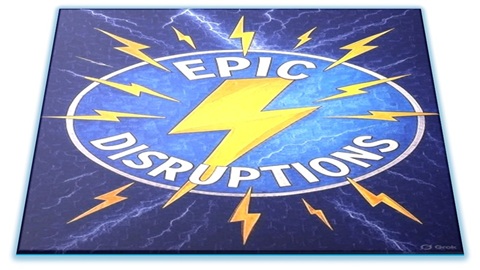
Leading Through Disruption: Scott D. Anthony on the Mindset, Mechanics, and Meaning of Transformative Innovation

Disruption isn’t chaos—it’s change made accessible. As Professor Scott D. Anthony of Dartmouth’s Tuck School of Business and author of Epic Disruptions: 11 Innovations That Shaped Our Modern World (Harvard Business Review Press, September 2025) told me during our recent Business of Government Hour conversation:
“A disruption takes something that was complicated and expensive and makes it simple and affordable. It changes market dynamics and drives dynamic growth.”
Too often, leaders—especially in government—view disruption as a threat to stability. But as Anthony reminds us, when understood correctly, disruption is a force for democratization. It expands access, accelerates progress, and rewards those who lead with curiosity, patience, and courage.
In this piece, I explore the essential insights from our discussion and his new book—what truly drives disruption, the human behaviors that fuel innovation, and how government leaders can harness change without losing control. Anthony's perspectives, influenced by his two-decade collaboration with the late Clayton Christensen, emphasize curiosity, persistence, and strategic foresight –equipping listeners and readers with actionable insights for transformative leadership.
Redefining Disruption
A central leadership insight is the necessity of accurately defining disruption to avoid strategic pitfalls. Anthony’s first warning is conceptual: disruption is one of the most misused words in leadership discourse.
He notes that famed thought leader Clayton Christensen’s “biggest regret about his research is that he picked the word disruption” because it carries negative connotations.
“If I say the word disruption,” Anthony explains, “you probably will think about a time a trip was disrupted because of a flight delay. You think of something bad that happened in your life.” But in the Christensenian sense, disruption is not destruction—it is innovation. For government leaders, getting this right matters. As Anthony elaborates, "in government... you need to understand the disruptions that are going to reshape markets or the new innovations that are coming that change the way that we work and create the conditions that maximize the upside of these disruptions and minimize the downside."
Patterns of Disruptive Change
Anthony’s study of eleven innovations—from gunpowder to generative AI—reveals that disruption is not random.
“Disruption changes the world for better and sometimes for worse. Disruption is predictably unpredictable. And disruption rewards people who are patient and persevere.”
Each pattern offers lessons for public leaders tasked with governing amid volatility. The first reminds them to be vigilant about unintended consequences; the second underscores that disruption unfolds in discernible but nonlinear ways; and the third emphasizes the moral quality of persistence. As Anthony puts it, “There are no overnight successes.
Characteristics of Disruptive Leaders
Anthony profiles a diverse array of disruptors, from Renaissance scientists to modern rebels. He identifies five behaviors of disruptors—curiosity, customer obsession, collaboration, ambiguity adeptness, and persistence—as essential for transformation. These traits, drawn from the book's iconoclasts, show innovation is human-driven and attainable through habits.
Interestingly, “Julia Child was the perfect innovator,” he declares. Using Child as an exemplar, Anthony further describes these five behaviors.
- Disruptive innovators are intensely curious. “They question the status quo,” Anthony explains. “Julia Child devoured cookbooks on different subjects… She went super deep.” Curiosity is the antidote to complacency—a mindset essential in bureaucracies that often default to “we’ve always done it this way.”
- They obsess over customers. They put themselves in their users' shoes and solve real problems. Child's customer focus revolutionized cookbooks with a two-column layout—ingredients on the left, instructions on the right—born from empathizing with everyday cooks: "Julia's desire to say I want to imagine myself not a chef trained at Le Cordon Bleu, but a normal person in a kitchen,” says Anthony.
- Successful innovators are collaborative. Collaboration was also key. As Anthony notes, "Magic happens at intersections with different mindsets and backgrounds collide." Julia Child worked with co-authors and benefited from her husband's support, recognizing that innovation rarely happens in isolation.
- They are adept in ambiguity. They recognize that "success is not a straight line. It's not that you come up with a plan and then you act. It's you come up with an idea that you test, that you fail, that you learn." Child tested 30 versions of her baguette recipe, using 284 pounds of flour, before perfecting it.
- They persist through adversity. Julia Child's masterwork took ten years to complete, involved three different publishers, and survived two near-death experiences. As Anthony emphasizes, "There are no overnight successes."
These five behaviors, Anthony implies, are universal—not just for entrepreneurs or scientists, but for civil servants leading modernization or digital transformation efforts.
When the Right Choices Look Wrong
Anthony revisits Christensen’s signature insight: “When disruption strikes, the right choices can often look like the wrong ones.” The story of Bethlehem Steel’s downfall to Nucor’s “mini mills” exemplifies this paradox. Investing in cheaper, emerging technologies seemed irrational—until it became existential.
For government, this counterintuitive logic applies to decisions that may appear inefficient or risky in the short term but are necessary for long-term transformation. “It requires really having long-term orientation in a short-term obsessed world,” Anthony says pointedly.
Distinguishing Failure from “Too Early”
Leadership in disruption demands judgment—the ability to distinguish between genuine failure and ideas “ahead of their time.” Anthony’s favorite case study comes from Procter & Gamble’s development of Pampers.
Between 1956 and 1964, P&G failed multiple test markets before achieving success. “Why did they persevere? Because they were working on a problem worth solving.” When failure results from executional issues, keep going. When failure reveals a problem that doesn’t truly matter to users, pivot or stop.
His advice for innovators—public or private—is simple but profound: “Persevere when the problem is persistent and important. Pull the plug when it isn’t.”
Florence Nightingale’s Lesson: Three Arrows of Systemic Change
Among the book’s most compelling historical disruptors is Florence Nightingale. Anthony reframes her not merely as “the lady with the lamp” but as “a data scientist, reformer, and systems thinker.”
“Florence Nightingale launched three distinct disruptions,” he explains:
- Visualization grounded in data – Her “interocular” (literally hitting between the eyes) diagrams made the case for sanitary reform.
- Accessible communication – Her Notes on Nursing translated scientific insights into plain language.
- Training and institutionalization – Her nursing school created the profession itself.
For today’s public leaders grappling with health reform, natural resource resilience, or AI governance, Nightingale offers a timeless blueprint:
“Visualization to make the case for change, words to make it understandable, and training to enable it. That’s what system change is all about.”
Exorcising Organizational Ghosts
Later in the interview, we explored how organizations’ past successes can inhibit innovation—a phenomenon Anthony calls “ghosts.”
“Institutional memory can be a real strength… but it can also hold you back,” he observes. “We’ve always done it this way. We tried that 73 years ago and it didn’t work.”
To “exorcise” these ghosts, leaders must challenge ingrained habits. Drawing on his earlier work Eat, Sleep, Innovate, Anthony recommends embedding innovation into daily routines through what he calls “BEANs”—Behaviors, Enablers, Artifacts, and Nudges.
He illustrates with a vivid example from the gaming company Supercell: when teams succeed, they open a beer; when they shut down a failed game, they open champagne, write lessons on the bottle, toast, and move on. “It’s a simple ritual, but it has powerful impact.”
Public organizations, too, can institutionalize such rituals to normalize experimentation and learning rather than fear of failure.
Constraints as Creative Catalysts
Professor Anthony tackles head-on the perception that government faces unique barriers to innovation. While acknowledging real constraints—procurement rules, risk aversion, public accountability—he notes a universal truth: "Everybody thinks it is uniquely hard for them."
He flips the logic of constraint: “Constraints enable creativity.” Using the metaphor of light, he explains: "If you have no constraints or no filters...you get a really dim light. If you focus it, you get a laser that can do some really powerful things."
The key is finding ways to experiment within constraints. For example, Singapore’s “regulatory sandbox” for fintech allowed experimentation within controlled boundaries—a model other governments can emulate to innovate responsibly. The challenge, he emphasizes, is cultural: “Nothing stops governments from experimenting aside from their own perceptions of what their limits are.”
Innovation and Reliability: Two Sides of the Same Coin
Anthony rejects the false dichotomy between innovation and reliability. Pointing to Toyota’s production system, he observes, “If we want to make sure things are as reliable as possible, we need to constantly be innovating.”
Curiosity and discipline coexist; they are complementary, not contradictory. For government, this insight offers a way forward: innovation can be structured, systematic, and repeatable without sacrificing trust or accountability.
From Dual Transformation to Epic Disruption
In his earlier book Dual Transformation, Anthony and co-author Mark Johnson argued that leaders must both “reinvent today” and “create tomorrow.” Epic Disruptions, he explains, deepens that thesis by providing the historical and psychological grounding for why transformation is so hard—and so necessary.
“Disruption is coming,” he says plainly. “If you’re going to transform, it’s not a one-shot deal. It’s a two-shot deal.” His latest work equips leaders with the mindset, tools, and stories to manage both the promise and peril of that process.
Conclusion: The Human Element
Throughout the interview, Professor Anthony emphasized that disruption ultimately results from human choices and human behaviors. In a world of accelerating change, that may be the most enduring insight of all: disruption is ultimately a human story. Its power lies not in the technologies that drive it, but in the leaders who dare to make meaning of it. Anthony’s message to leaders today is both a challenge and an invitation:
- Redefine disruption not as threat, but as democratization.
- Cultivate the five behaviors—curiosity, empathy, collaboration, adaptability, and persistence.
- Anticipate second-order effects and design policy for both the promise and the shadow.
- Institutionalize experimentation while maintaining public trust.
- Embrace constraints as catalysts for creativity.
- Balance innovation and reliability through structured curiosity.
For leaders facing daunting transformation challenges, this message offers both realism and hope. Disruption is predictably unpredictable. It requires patience, persistence, and the courage to make choices that look wrong in the moment but prove right over time. It casts shadows that must be actively managed. But it also represents humanity's most powerful tool—and the capacity to shape it remains firmly in human hands.



